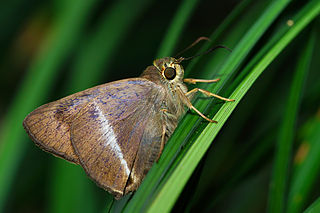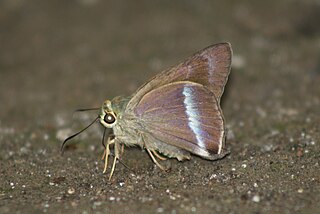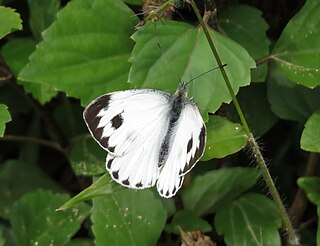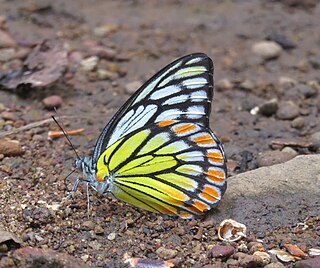
Leptosia nina, the psyche, is a small butterfly of the family Pieridae and is found in Indian subcontinent, southeast Asia and Australia. The upper forewing has a black spot on a mainly white background. The flight is weak and erratic and the body of the butterfly bobs up and down as it beats its wings. They fly low over the grass and the butterfly rarely leaves the ground level.

Hasora badra, the common awl, is a butterfly belonging to the family Hesperiidae, which is found in India.

Hasora taminatus, the white banded awl, is a butterfly belonging to the family Hesperiidae, which is found in Asia.

Hasora vitta, the plain banded awl, is a butterfly belonging to the family Hesperiidae which is found in India and parts of Southeast Asia.

Caleta caleta, the angled Pierrot, is a species of blue butterfly found in Sulawesi.

Zizula hylax, 'the Tiny grass blue' is a species of blue butterfly.

Papilio (Chilasa) slateri, the blue striped mime, is a swallowtail butterfly found across south and south-east Asia. The butterfly belongs to the mime subgenus, Chilasa, of the genus Papilio, the black-bodied swallowtails. The nominate subspecies is found in India and is also called the brown mime. It is a good example of mimicry among Indian butterflies.

Stiboges nymphidia, the columbine, is a small but striking butterfly found in the Indomalayan realm that belongs to metalmark butterflies, related to Punches and Judies. It is the sole member of the genus Stiboges Butler, 1876.

Pieris canidia, the Indian cabbage white, is a butterfly in the family Pieridae found in India, Nepal and Indochina. Pieris rapae is one of the most closely related species in the Pieridae.

Pareronia ceylanica, the dark wanderer, is a medium-sized butterfly of the family Pieridae, that is, the yellows and whites. It is found in Sri Lanka and India.

Prioneris sita, the painted sawtooth, is a small butterfly of the family Pieridae, that is, the yellows and whites, which is found in south India and Sri Lanka.

Appias indra, the plain puffin, is a small butterfly of the family Pieridae, that is, the yellows and whites, which is found in south and southeast Asia.

Appias libythea, the striped albatross, is a small butterfly of the family Pieridae, that is, the yellows and whites, which is found in south and southeast Asia.

Appias panda, the Nicobar albatross, is a small butterfly of the family Pieridae, that is, the yellows and whites, which is found in the Nicobar Islands of India.

Colias berylla, the Everest clouded yellow, is a small butterfly of the family Pieridae, that is, the yellows and whites, which is found in Sikkim (India) and Tibet.

Libythea myrrha, the club beak, is a butterfly found in India that belongs to the Libytheinae group of the brush-footed butterflies family found in the Indomalayan realm.

Cheritra freja, the common imperial, is a small butterfly found in India, Indochina, Malaysia and Sri Lanka that belongs to the gossamer-winged butterflies family (Lycaenidae).

Spalgis epius, commonly known as the apefly, is a small species of butterfly found in the Indomalayan realm that belongs to the lycaenids or blues family. It gets its name from the supposed resemblance of its pupa to the face of an ape.

Prosotas aluta, the banded lineblue, is a species of blue butterfly (Lycaenidae) found in Asia. The species was first described by Herbert Druce in 1873.


























